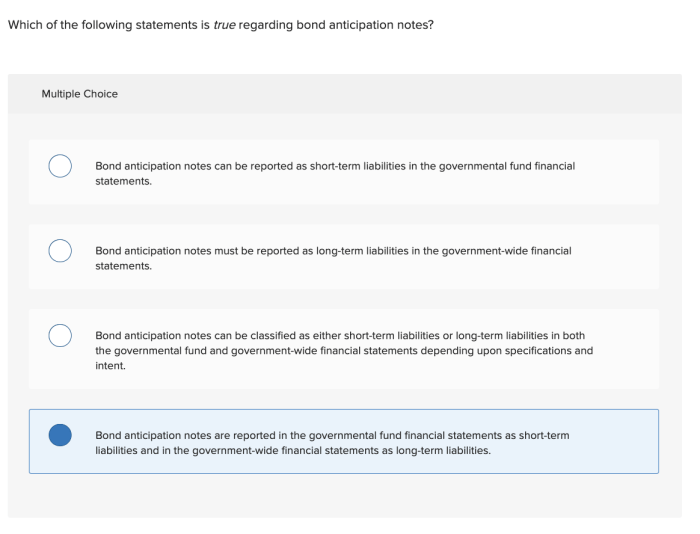Which of the following statements regarding bonds is true? This question delves into the intricacies of the bond market, shedding light on the nature, characteristics, and dynamics that govern these financial instruments.
Bonds play a pivotal role in financial markets, facilitating capital formation and providing investors with a means of generating returns while managing risk. Understanding the nuances of bonds is crucial for informed decision-making in the realm of fixed-income investments.
Bond Basics: Which Of The Following Statements Regarding Bonds Is True

Bonds are debt instruments that represent a loan made by an investor to a borrower. They play a crucial role in financial markets, providing capital for governments, corporations, and other entities.
There are various types of bonds, including corporate bonds, government bonds, and municipal bonds. Corporate bonds are issued by companies to raise funds for operations or investments. Government bonds are issued by governments to finance public spending or infrastructure projects.
Municipal bonds are issued by local governments to fund specific projects, such as schools or roads.
Key characteristics of bonds include maturity, coupon rate, and face value. Maturity refers to the date when the bond’s principal is repaid to the investor. Coupon rate is the annual interest payment made to the bondholder. Face value is the amount that will be repaid at maturity.
Bond Pricing and Valuation
Bond prices are influenced by various factors, including interest rates, inflation, and credit risk. Interest rates have an inverse relationship with bond prices: when interest rates rise, bond prices fall. Inflation can erode the value of future interest payments, leading to lower bond prices.
Credit risk refers to the risk that the bond issuer may default on its obligation, which can also impact bond prices.
Bond prices can be calculated using formulas such as the present value of future cash flows and yield to maturity. The yield to maturity represents the annualized return that an investor would receive if they held the bond until maturity.
Bond Returns and Risks

Bonds can generate returns in two ways: through coupon payments and capital appreciation. Coupon payments are the regular interest payments made to bondholders. Capital appreciation occurs when the bond’s market price rises above its face value.
Investing in bonds also carries risks, including interest rate risk, credit risk, and liquidity risk. Interest rate risk refers to the risk that bond prices will fall if interest rates rise. Credit risk refers to the risk that the bond issuer may default on its obligation.
Liquidity risk refers to the risk that a bond may be difficult to sell quickly without incurring a loss.
Strategies for managing bond risks include diversification, laddering, and active management.
Bond Market Analysis
Key indicators used to analyze the bond market include the yield curve and bond spreads. The yield curve plots the yields of bonds with different maturities. Bond spreads measure the difference in yields between bonds of different credit qualities.
Bond market data can be interpreted to identify trends and make investment decisions. For example, a steepening yield curve may indicate expectations of rising interest rates, while narrowing bond spreads may suggest improving credit conditions.
Bond Investment Strategies

Different bond investment strategies include laddering, barbell strategy, and active management.
Laddering involves investing in bonds with different maturities to spread out the risk of interest rate changes.
Barbell strategy involves investing in a mix of short-term and long-term bonds to balance risk and return.
Active management involves actively buying and selling bonds in response to market conditions.
When selecting bonds for an investment portfolio, factors to consider include the investor’s risk tolerance, time horizon, and return objectives.
Questions and Answers
What are the key characteristics of bonds?
Bonds are typically characterized by their maturity date, coupon rate, and face value.
What factors influence bond prices?
Bond prices are influenced by interest rates, inflation, and credit risk.
What are the different types of bond returns?
Bond returns can be generated through coupon payments and capital appreciation.
What are the risks associated with investing in bonds?
Bond investments carry risks such as interest rate risk, credit risk, and liquidity risk.
How can investors manage bond risks?
Bond risks can be managed through diversification, duration management, and credit analysis.